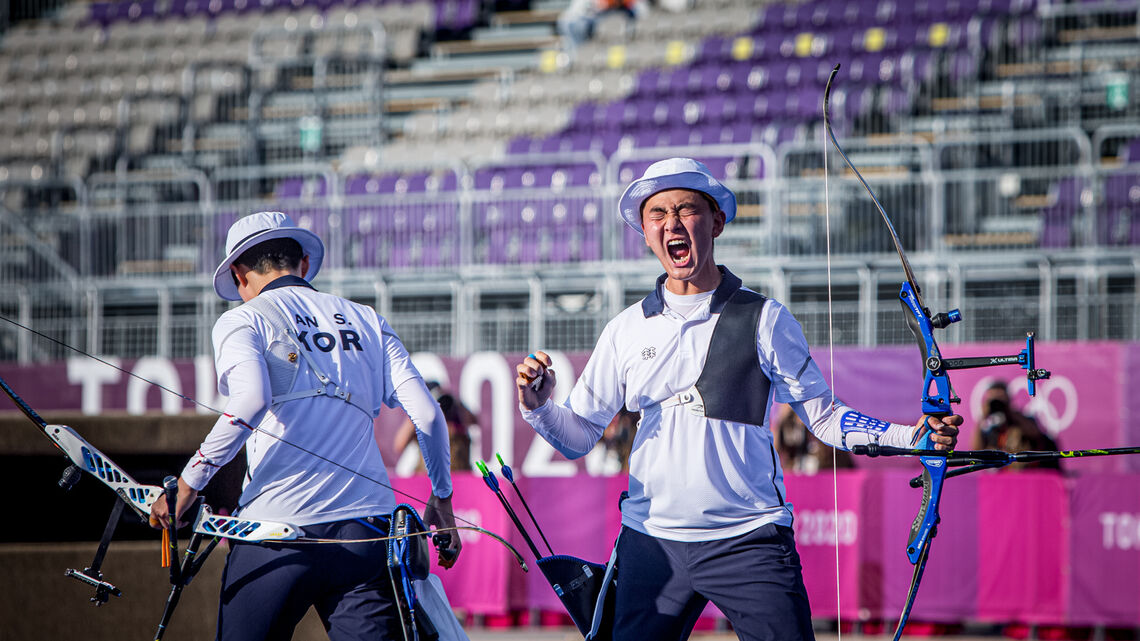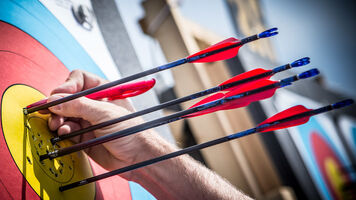How Korea’s school system produces the world’s best archers

For the past 40 years, Korea has been archery’s leading competitive nation at the Olympic Games.
The country has won 27 out of a possible 45 gold medals since making its debut at Los Angeles 1984 – and eight of a possible nine over the last two editions in Rio and Tokyo.
Team events were introduced to the Olympic programme in 1988. The Korean women are unbeaten at the Games. Nine consecutive wins.
Such sustained success is simply unprecedented in world sport.
It’s an oft-repeated trope, both in Korea and out, when archers say that making the Korean team is harder than winning an Olympic gold medal.
The statement is sometimes taken as a review of the quality of opponents – but it’s really more about the comparison of a single event, the Games, against the rigorous annual selection process and systems in place to ensure Korean results.
These systems begin at a very young age.

Kim Je Deok won two gold medals in Tokyo at the age of 17, less than eight years after picking up a bow in an after-school class.
“I started archery in the third grade of elementary school,” he explains.
“After attending regular school classes in the morning, archery classes started in the afternoon. If there were upcoming competitions, I trained on the weekends, too.”
It is not nearly true that every school in Korea has an archery club.
There are about 900 archers practising in elementary school clubs across the country – in probably around 100 clubs. It’s a model that was used for many sports in Korea, but while similar football, basketball and baseball elementary school teams have closed, archery has remained.
“As an elementary school kid, I shot around 300 to 500 arrows per day,” says Je Deok.
“These days I shoot around 300 to 400 and try to focus more on the result than the amount.”
According to the Korean Archery Association, most elite Korean archers start in the sport at around the age of nine or 10 as part of after-school classes.
They train from Monday to Friday for three to four hours per day, from the end of the school day – until the end of the working day. The archery club is, in the simplest of terms, daycare.
The difference, perhaps, to European practises (for example) is that after-school clubs would be more diverse, with participants trying many sports rather than focusing – at such a young age – on one.
Young archers in Korea spend three to four hours per day on this single sport, in which repetition is fundamental, compared to perhaps a couple of hours a couple of times a week is enormous.
If Je Deok shot an average of 375 arrows a day, five and a half days per week, for the nine years before winning two Olympic golds, he’d already shot, in total, a million arrows.
Though clearly talented, his results didn’t arrive by magic, simply through quantity of time, the quantity of arrows, and quantity of energy invested in becoming a champion.

“I started archery in the fourth year of elementary school,” says Athens 2004 Olympic Champion Park Sung-Hyun, widely regarded as one of the greatest Korean female archers of all time.
“The school coach recommended I try as a club activity and everything started from there. It’s not accessible for all Koreans to try archery so it really was a coincidence that brought me here.”
School clubs are largely funded by the schools themselves.
Equipment is given to the archers – and there are no entry fees for tournaments run for school, university and club teams.
“We try to build good basic posture so that the young archers can continue to the next level,” says Lee Jiho, an elementary school coach in Seoul.
The focus is not purely on sport – but also on care. It’s not uncommon for archers to break halfway through practice to spend time together on homework.
“But in training, we focus also on raising students and helping them grow as a person,” adds Du Gayeong, who coaches in a middle school.

Of the 900 elementary school archers at any given time, around 60% progress to a middle school archery club. Half of those continue to high school – and by the time the education system reaches university, there are around 150 club archers.
For practical reasons, most of the schools with archery clubs are located quite close to each other.
University archery clubs compete with those associated with professional teams – which are departments of companies or cities, which continue to invest in this structure of sports performance past school age. Combined, there are about 60 adult teams in Korea.
While the number of archers is actually very small, the system is built on quantity. The quantity of time and practice expended by a select group, who start young.
Very few of the archers who begin shooting at the age of nine or 10 end up representing the country at the international level.
In any given year, eight recurve men and eight recurve women are named to the Korean squad – with only half of those competing at the most prestigious events. They’re selected after months of annual, rigorous trials, after years of progression through a system designed to funnel the most promising athletes to the top and create champions.

What is there to learn, from the outside, looking in on the Korean education system for archery?
Obviously – there is no magic potion for success.
But also that Korean archers who do achieve phenomenal results are, in reality, lucky. They are fortunate to live close to an elementary school with a club and enter a system that allows them to thrive.
The other side of the sport’s structure in Korea – the one in which clubs offer a recreational space for people to enjoy archery – is small but developing. It simply wasn’t the purpose of the system created to build a winning national team.
And the system doesn’t stop at the end of an archer’s competitive career.
“After retiring, I have an interest in coaching more than anything else,” says Ki Bo Bae, the London 2012 Olympic Champion.
“My biggest goal is to help develop young archers who are just like me.”
After 40 years of success, Korea has a wealth of international expertise and experience, being reinvested into the next generation of aspiring young athletes – and the generation after that.
In this way, the cycle of producing incredible archers goes on.


